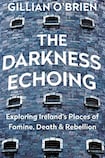
In January 2015, some 20,000 outraged signatories endorsed a petition against a sitcom announced by Channel 4 that would be set during the Great Famine. Many found the notion that modern Ireland’s greatest tragedy would provide fodder for comedy hard to stomach, and Channel 4 quietly shelved the project. Yet three years later the film Black ‘47, which uses the Famine as background for a gory tale of revenge, was received enthusiastically.
Why the one but not the other? What are the ethics of representing troubled histories, particularly if your purpose is to monetise them? Gillian O’Brien’s The Darkness Echoing explores this question by investigating the phenomenon of dark tourism, “travel to places associated with suffering or death”.
O’Brien is an academic historian and heritage consultant, but The Darkness Echoing is not simply a scholarly analysis. The book describes visits to a wide range of sites, including museums, prisons, workhouses, graveyards, neolithic burial grounds, churches and haunted houses. Reviewing such places, O’Brien asks incisive questions about how the past is remembered.
The first two chapters concern war and rebellion, from the Jacobite war of 1688-1691 and the 1798 United Irishmen rising to the revolutionary period. Another chapter focuses on tourist attractions dedicated to maritime disasters, most prominently the Titanic. The chapter on emigration examines the choices museums make in telling the story of Irish emigration. A powerful chapter on death considers graveyards, megalithic tombs, and the ethics of exhibiting bog bodies and other human remains, as well as Irish funerary traditions.
The finest parts of the book are those on the Great Famine and the history of incarceration in Ireland. Here O’Brien offers her most stimulating observations. Discussing why it is so challenging to properly represent those who perished or left during the Famine, she echoes scholars of Famine commemoration such as Emily Mark-FitzGerald and Niamh Ann Kelly: “the poor leave little behind”. Institutions such as the National Famine Museum at Strokestown have therefore had to develop “imaginative ways to tell the stories of the poor”.
The point about class and representation is central to the poignant chapter on sites that explore the history of incarceration
O’Brien demonstrates this herself with a beautifully deft analogy. Describing an object at the Skibbereen Heritage Centre – a 25kg sack of potatoes, the average daily amount needed to feed a family of six before the Famine – she remarks that “twenty-five kilos weighs 2½ times the Ryanair carry-on”.
The point about class and representation is central to the poignant chapter on sites that explore the history of incarceration. Entries in prison registers are often the only information we have about ordinary inmates, as opposed to high-profile political prisoners such as John Mitchel and the leaders of the Easter Rising. The names and stories of many poor folks, often imprisoned for minor crimes, have only survived “because of a sentence or two in a ledger”. Such chilling observations underscore the importance of the heritage industry.
However, the book is also often funny. The narrative features jokes galore and is interspersed with comic anecdotes about O’Brien’s grandmother, Nana. She and other relatives and friends often accompanied O’Brien on her visits, offering a counterpoint to her academic perspective. A few of O’Brien’s wisecracks seem overly sarcastic. But some of her aperçus have an aphoristic, lapidary quality: “There’s little room for nuance at a bonfire.”
The use of humour also reflects O’Brien’s scepticism about the ways the past is politicised and marketed. A strong refusal to comply with nationalist mythology is evident throughout the book, and the final chapter traces how history is instrumentalised for the construction of national identity. Such reflections on the dilemmas of cultural memory build profitably on the work of scholars such as Mark-FitzGerald, Guy Beiner and Emilie Pine.
An approach critical of the orthodoxies of Irish nationalism is a brave one to take in a book like this. O’Brien’s judgments can be caustic, but her points are compelling. For instance, she rightly dismisses Tim Pat Coogan’s Famine potboiler The Famine Plot for its “wilful misreading of the evidence”. Moreover, she has no time for people who support the Irish slavery myth, which has been thoroughly debunked by Liam Hogan and others.
The Darkness Echoing is as thought-provoking as it is informative and entertaining
Such cultural critique is reminiscent of Roy Foster’s work, particularly his Paddy and Mr Punch and The Irish Story. Liam Kennedy’s notable work on the role of victimhood in the Irish self-imagination is also quoted approvingly.
The book concludes with a timely call to reform the national heritage industry. O’Brien highlights how mainstream versions of the Irish past often exclude marginalised groups, such as the Traveller community, women oppressed by church or State, LGBTQI+ people and recent immigrants to Ireland. In O’Brien’s view, museums and heritage sites should embrace the moral imperative to represent more critically and fully the complexities of Ireland’s past.
With such powerful conclusions, The Darkness Echoing is as thought-provoking as it is informative and entertaining.
Christopher Cusack is an academic and writer based in the Netherlands. He publishes frequently on the Great Famine and the Irish diaspora









